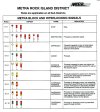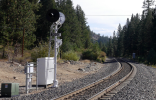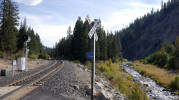OK I now understand my confusion.
There seem to essentially be three systems:
A: Speed signalling - signals explicitly indicate what speed is required at divergences
B: Route signalling as used in North America - signals implicitly indicate speed at divergences - it's up to the driver to know the appropriate speed, but route indication is limited to what is needed in order to do so. There is no distinction between multiple diverging routes at the same speed (or information on whether the divergence is to the left or right).
C: Route signalling as used in the UK - signals fully indicate route (and thus also implicitly indicate speed). But if there are multiple routes, each is shown separately even if they are to be taken at the same speed. If it's possible to reach one of 12 platforms in a station then the signal needs to be able to distinguish between all 12 even if the speed is 20 mph for all of them. Even if there is just one route, it will be indicated whether it's to the left or right.
I have been (incorrectly, it seems) thinking of only C as being route signalling.
Yes, this is one way of looking at it. American signaling started out as "C" as well, but true "C" design is a lot harder to find these days.
North American doesn't use feathers, but there have been and are ways of displaying a track or route number or ID when it is necessary. Today this is typically done with a large LED-matrix display which light up LEDs according to alphanumeric characters.
For example in Canadian rules, then a single green or yellow indicates speed at the signal by its position (clear/medium/slow), and the state of the following signal by colour, as above. But only if the following signal is at clear or stop.
If the following signal is at an intermediate speed, the speed at the signal is indicated by the colour of the light in the second position with the third position indicating the speed at the next signal, again by colour.
The Canadian signal rules get pretty messy once you get down to the Slow speed aspects, in my opinion. It's not an intuitive system. But, at least it's sort-of logically consistent.
Just from casual observation on my visits to the US, I'd very much agree with that - on the 'route signaling' railroads three stacked heads are not very common.
Not common, but not rare, either. They are used where they are needed. While I attribute most such usage to the need to display advanced aspects (e.g. using more than one signal head), such as
Diverging Approach Diverging (Red over Yellow over Yellow), there are surely situations of different track/switch speeds, too.
With speed signaling, three-head signals are more common, depending on the detailed idiosyncrasies of the schema too.
Another thing that wasn't immediately obvious to me years ago is that generally automatic signals (the ones with number plates below the heads) are permissive - the most restrictive indication is 'proceed at restricted speed' or equivalent. I assume this came about because early automatic block signal installations long pre-date train radio communications, so it kept trains moving (slowly) in the event of signal failures.
Exactly correct.
"Automatic signal" is a bit of a fuzzy term to me, because it implies it is completely automatic and only actuated by trains in the signal blocks near it. Most permissive signals have more safety features (such as a
tumbledown) which results from the detection of a direction traffic entering the single-track stretch between sidings/junctions.
Out of curiosity, in the (my) picture below is what appears to be a both-directions automatic signal in what I think is a CTC area, with on the far side of the post (facing westbound trains) a smaller subsidiary light below the main head. It's on the ex-Western Pacific route west of Portola, now the UP Canyon Sub,
looking southeast at the Camp Layman Road grade crossing. There is a passing loop about 2.5 miles west/behind the camera, so maybe the subsidiary light is associated with entry to that loop:
Yes, correct again. That lower lamp is what I mentioned before in this thread as a
marker lamp. It only lights up one color and is dark when not otherwise needed. That lamp is surely Yellow colored, and lights up when the signal needs to display
Approach Diverging (Yellow over Yellow) for when the siding track is to be taken at the next signal.
According to the satellite view, that signal still exists as a searchlight, if the view is current.... though its innards could have been ripped out and changed to a solid-state replacement. I only mention that because searchlights are largely gone due to the fact they're integral to the signal block wiring but which is not compatible with microprocessor-driven Positive Train Control systems.
...which is (as I understand it) basically what the presence or absence of a signal number plate in the US implies i.e. no number plate means it's a controlled absolute signal (but which may be able to display a 'proceed at restricted speed' aspect which is different from the 'stop' aspect). So the same signal aspect can convey a different instruction/authority depending on if the signal has a number plate or not.
I have a few pedantic corrections to add here:
All controlled signals are absolute, but not all absolute signals are controlled signals.
Controlled means that it's under the control of the dispatcher/control operator/etcetera about whether it shows
Stop, or something better (track conditions permitting). Such locations of signals are called a
control point, these are almost always interlockings. But, some American methods of working use absolute signals that are not controlled.
Here is an example to read about.
Technically speaking, the number plate is part of the signal aspect along with the lights. With or without a number plate are two different aspects, especially since the rules stipulate that it makes a difference.
I'm not sure about in Britain, but in the US,
authority is a special term that that describes the right or permission of a train to occupy a (main) track. In North America, Centralized Traffic Control (CTC) (or its equivalent) is the only method of working where the signals themselves convey and grant movement authority. In lesser systems, like Automatic Block Signaling (ABS) or Absolute Permissive Block signaling (APB), the signals are just an extra layer of safety over the method of working, and authority must be conveyed separately.
I don't know how the term aspect is defined but it would seem helpful to me to consider any relevant plates as part of the aspect.
Yup!
In the Canadian rules, a single red is passable - two or three reds aren't.
With exceptions of course - a single red with an "A" plate isn't passable, two reds on opposite sides of the pole are...
This is, of course, an opportunity for wrong-side failure. If the "A" placard falls off or is removed, the Red signal is instantly upgraded from
Stop Signal to
Stop and Proceed Signal and that's very-much a bad thing.
That's a very American attitude to safety - "they should know the rules, why should we bother safeguarding against error?".
That isn't what I wrote. I wrote that they should know their territory, and consequently will know how to comply with the rules. Each location and specific circumstance is different, and one location may allow the crew to put off slowing down significantly for a while, while another location may need them to do so right away.






